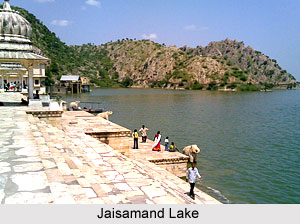 Jaisamand Lake is one of the biggest attractions of Udaipur city. Located at a distance of 52 kms southwest of Udaipur city it is one of Asia`s largest lakes. Jaisamand Lake covers an area of 36 sq kms. It enjoys a splendid sight of evergreen forests that create the backdrop of the lake. On the bank of the lake there are is a small temple dedicated to Lord Shiva commissioned by Maharaja Jai Singh. These are built in typical Rajasthani style. Jaisamand Lake includes one of the exclusive bird sanctuaries which often receives different types of migratory birds.
Jaisamand Lake is one of the biggest attractions of Udaipur city. Located at a distance of 52 kms southwest of Udaipur city it is one of Asia`s largest lakes. Jaisamand Lake covers an area of 36 sq kms. It enjoys a splendid sight of evergreen forests that create the backdrop of the lake. On the bank of the lake there are is a small temple dedicated to Lord Shiva commissioned by Maharaja Jai Singh. These are built in typical Rajasthani style. Jaisamand Lake includes one of the exclusive bird sanctuaries which often receives different types of migratory birds.
Jaisamand Lake is one of the exclusive sites of Udaipur. The lake was one of world`s largest artificial lakes till the Aswam dam was built in Egypt. The lake stretches 9 kms in breath and is 102 feet deep with a circumference of 30 miles with some exclusive marble staircases that descend in the water. Jaisamand Lake is also known for the island attractions. There are seven islands on the lake and the tribe of Bhil Minas inhabit these islands. There are two main islands which are large in size. The biggest island is called Babaka Bhagra while the smallest is called Piari.
There is a bund on the lake which attracts attention because of its height and length and structure. The bund is 1202 feet long, 116 feet high and 70 feet broad at the base. Along with it there is a Shiva temple located on the dam. The dam has six exotic cenotaphs and a Shiva temple at the centre. The northern end of the lake has a palace with a courtyard while its southern end has a pavilion with 12 pillars. The hill is surrounded with evergreen forests which have a number of palaces that enjoy the scenic beauty of the lake. It allows its tourists to enjoy splendid rides on motorboats and they can also enjoy diving and swimming.



















